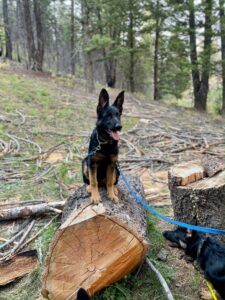By Fran Jewell

Most of us dog owners love to walk our dogs. We are so blessed to have some of the most magnificent places to walk our dogs that are postcards at every turn along the path! We love the time we spend with our dogs and this special place we call home.
Taking our dogs with us also brings some special responsibilities. We must be sure that our dog has a dynamic recall and will come back even in the face of chasing a deer, a bunny or a chipmunk. We must also be sure that our dog will not mug or jump on others that are out enjoying our wilderness trails, too. There are so many owners that will deceive themselves into believing a dog that runs up to a person or dog while barking is just being “friendly” when, in fact, that can be fear based, or even territorial behavior. It is not friendly behavior. Saying it is is just an excuse for having a poorly trained dog.
There are many ways to help prepare your dog for these encounters along the trail so it is enjoyable for everyone. Mastering the “come” command at home before allowing a dog to run off leash is imperative. Teaching “come” takes a lot of time for it to be reliable in any situation; it is not something that a dog learns in one or two teaching sessions. There are lots of modalities to teach “come,” as well. It should be something practiced every day in the house, in the yard, on a long line, as long as the dog lives. Setting your dog up for success is part of that mastery. Take your tools: a leash, food or toy reward, and poop bags along as part of the commitment you must make before you put on those hiking shoes or skis.
A really helpful skill is the idea of coming WITH YOU, not just TO you. Keep walking. If your dog wants to stop and sniff another dog, keep walking by. Pick up your pace. Always reward your dog for deciding to come with you instead of stopping to sniff. Many times that stop to sniff can turn ugly if two dogs don’t like each other. In many ways, dogs are like people; they don’t like every dog (or person) they meet. Most dogs will choose to stay with you if you keep moving. If they don’t come along with you, change direction and start to run, then reward the dog for coming along with you. Most dogs do not like to be left behind. The same is true for skiing. Most people don’t have issues when they are skiing because the movement is fast and most dogs don’t have time to stop and sniff. Again, most dogs will not want to be left behind.
Walking is a tremendous activity if used correctly. For dogs that have never met each other, it can be a good tool for introductions. A walk on a leash with another dog can help smooth over a rocky dog relationship or even get a new doggie relationship off to a good start. The key here, though, is for each dog to be on a separate leash with a different person. That gives the dogs a chance to get to know each other without a lot of pressure, and it gives the dogs a sense of leadership from the humans.
Walking is good for us, our dogs and/or dog relationships with others. Being thoughtful about how to use walking as a tool instead of just something you do can make a wonderful difference in your dog’s behavior with others. Keep on walking!!
Fran Jewell is an IAABC Certified Dog Behavior Consultant, NADOI Certified Instructor and the owner of Positive Puppy Dog Training, LLC in Sun Valley. For more information, visit positivepuppy.com or call 208-578-1565.


